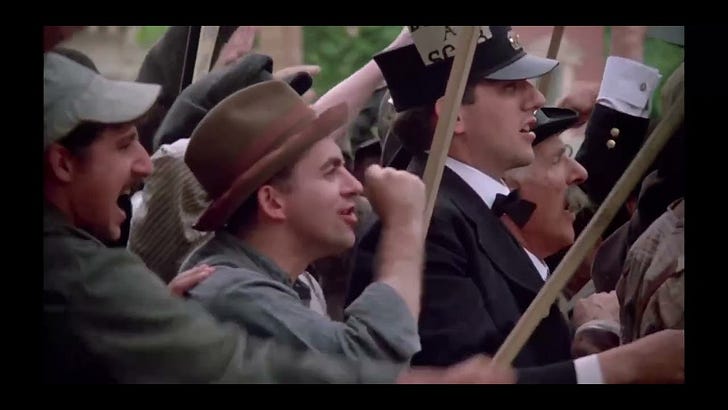Welcome to the Other Day. This is a blog that is regularly emailed to you. I won’t stop you from calling it a newsletter. It is called Other Day because I write everything days, weeks, maybe even months in advance. I’m doing this to counter the powerful incentives to be newsy, make predictions, and generally write stuff that feels outdated the next day. Here are some other constraints I’ve set for myself:
Posts are short. These go to your inbox so who wants long emails? I know I don’t. My goal (which I won’t always hit) will be to keep it under 800 words.
Everything here will be about small cities and towns. Some rural stuff. Suburbs can get some love too.
There will be some stuff that won’t seem like it is about small cities, towns, rural places, or the suburbs. It is, trust me.
I’ll have something every week for free subscribers at first. Later on free subscribers will get something every other week and paid subscribers will get something every week because I like them more.
A little after 11PM on Saturday, Aug. 31, 1946 in Albany, New York a hundred people gathered around Perry Vincent’s trolley as he piloted it out of the Quail Street car barn. They were there to say goodbye. Not to Perry but to the old rattling contraption he was operating. United Traction Company, which operated electric street cars in and around the city had just been authorized by the state’s Public Services Commission to convert their last remaining lines to buses. For nearly six decades streetcars had swept down steel rails connecting the state’s capital city to another five cities in the surrounding counties. The buses that replaced them were gas-powered but felt modern with padded seats and stops on the sidewalk instead of the middle of the road.
Streetcar usage reached its zenith a century ago in the United States. Then it disappeared as car adoption soared. When you read about why this happened, you get two stories. The first is a fairly straightforward argument like the ones made by Kenneth T. Jackson’s 1985 book Crabgrass Frontier or Jane Holtz Kay’s 1998 Asphalt Nation. General Motors lead a corporate conspiracy—along with oil, rubber, and other attendant industry players—to dismantle transit by creating a company called National City Lines that would buy up streetcar companies and convert them into bus lines. The service was intentionally worse than the cars they’d rather sell.
The second story acknowledges the first but, as this 2019 article in Curbed Los Angeles puts it: “By the time that National City Lines entered the picture, the dismantling of the streetcar system was well underway.” It isn’t a conspiracy; this is just one technology superseding the next. This kind of argument is repeated in just about every video or essay on the subject in the last five years. It is wrong, and it can be traced back to one paper written by a Portland, Oregon cosmetologist.
Back in 2018 -before the second story gained traction among the urbanist set- I wrote “Uber Alles” for Real Life mag (RIP). In the midst of researching that piece I came across Martha Bianco’s 1999 paper "Kennedy, 60 Minutes, and Roger Rabbit: Understanding Conspiracy-Theory Explanations of The Decline of Urban Mass Transit" and Cliff Slater’s 1997 paper General Motors and the Demise of Streetcars." Slater is a crank whose personal website suddenly stopped updating in July 2020 after a series of posts saying Covid-19 wasn’t such a big deal. His work on transit is disturbingly well-cited amongst professionals in the field. I’m glad I saw him for what he was at the time and never even mentioned his work.
Bianco, on the other hand, seems like a lovely person. After getting her Urban Studies PhD in 1994 she published a bit, pivoted briefly to adult-learner pedagogy, and then left academia to become a cosmetologist. Her 1999 paper makes her a kind of academic one-hit-wonder, likely because she offers a soothing alternative to the GM conspiracy. She argues that by casting “GM, the producer and supplier of automobiles, as the ultimate enemy” it helps us ignore “a shocking and nearly unfathomable alternative: What if the enemy is not the supplier, but rather the consumer? What if, to paraphrase Oliver Perry, we have met the enemy, and the enemy is us?”
But of course, the work of Peter D. Norton tells us that consumer choice is subject to marketing and in this case it was one of the most totalizing and effective marketing campaigns in history. Through a series of national ads and advocacy campaigns run through local motor clubs, car companies were able to make the car seem not only desirable, but inevitable. Against this backdrop it seems silly to talk about consumer choice.
But there’s one more aspect to this story that is rarely mentioned by Bianco or anyone citing her. The Union Traction Company was a union shop, and on more than one occasion the UTC union brought the Capital Region (and many other cities at different times) to a standstill as they fought for better pay and more frequent service. The car was a strikebreaker, a scab device, that let increasingly conservative white suburbanites control of their own transportation. Sure the big three automakers’ factories were union, but once the car left union hands it was free to betray its assemblers. The streetcar, by its nature as a staffed piece of machinery that everyone relied on, could be wielded as an effective means of labor power.
Some of the older ones in the crowd gathered to see off that last streetcar may have remembered the battle 45 years earlier between the United Traction Company workers and the New York State Police which saw the latter fire into the picket. This scene was portrayed in the 1987 movie Ironweed where the cops eagerly volunteered to portray their murderous forbearers.




